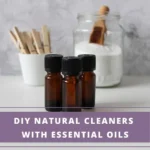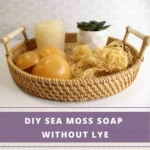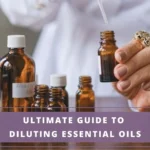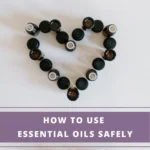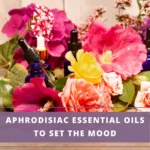As an Amazon Associate I earn from qualifying purchases. See Full Disclosure Here
Question: How many drops in 10ml essential oil?
Short answer: Approximately 200 – 240 drops of essential oil in a 10 ml bottle.
That’s just a general estimate though. When you’re following a recipe that calls for very precise measurements, you cannot use this approximation.
The exact number of drops in 10ml essential oil can vary depending on a couple of factors, mainly the viscosity of the oil and the dropper size.
Here’s what you should know when you’re looking for the exact number of drops in 5, 10, and 15 ml essential oil bottles. As you scroll below, you’ll also find some helpful essential oil conversions and usage tips.
How Viscosity Affects Number Of Drops In 10ml Essential Oil
 Viscosity refers to the thickness of a liquid. Honey, which is a very thick liquid, has high viscosity whereas water, which is a very thin liquid, has low viscosity.
Viscosity refers to the thickness of a liquid. Honey, which is a very thick liquid, has high viscosity whereas water, which is a very thin liquid, has low viscosity.
Different essential oils have different viscosities. Citrus essential oils are thinner and less viscous than herb and spice oils, which are dense and highly viscous.
Thinner citrus essential oils such as grapefruit and lemon, which are less viscous, will contain more drops of essential oil in a 10ml bottle.
Denser essential oils such as patchouli and vetiver, which are more viscous, will have fewer drops of essential oil in a 10 ml bottle.
The reason is that thicker, more viscous oils produce larger drops while thinner, less viscous oils produce smaller drops.
While the exact number of drops can vary, as a general guideline, most standard 10 ml bottles will contain around 200 – 240 drops.
You can narrow the range down further depending on the type of essential oil you’re using.
• Low viscosity citrus essential oils: approximately 240 drops essential oil in 10ml bottle
• High viscosity herb and spice essential oils: approximately 220 drops essential oil in 10 ml bottle.
Keep in mind that these numbers are approximate, and it’s always a good idea to start with fewer drops and adjust as needed.
Low-viscosity oils – lemon and frankincense
High viscosity oils – sandalwood patchouli
How Dropper Tip Size Affects Number Of Drops In 10ml Essential Oil
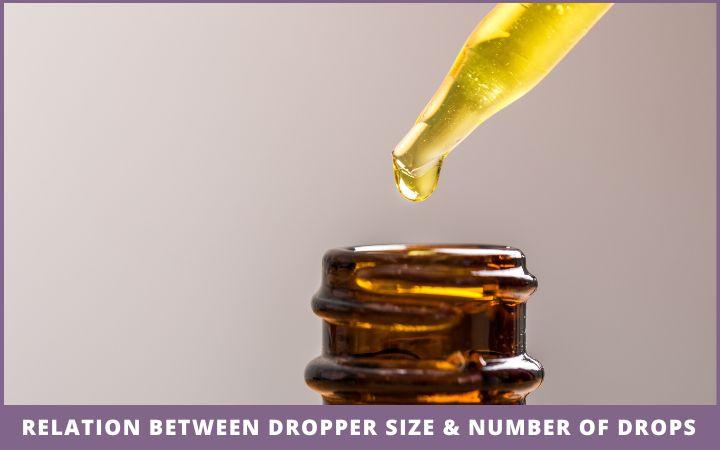 When you’re measuring the quantity of essential oil in drops, the size of the dropper tip will affect drop size and hence the number of drops. A small difference in the dropper’s design can make a huge difference.
When you’re measuring the quantity of essential oil in drops, the size of the dropper tip will affect drop size and hence the number of drops. A small difference in the dropper’s design can make a huge difference.
A dropper tip with a larger diameter will yield larger drops than a dropper tip with a smaller diameter. This can make a difference in the total quantity obtained.
So, 5 drops produced by a dropper tip with a larger opening will yield a larger total quantity as compared to 5 drops produced by a dropper tip with a smaller opening.
How Temperature Affects Number Of Essential Oil Drops In 10ml Bottle
Temperature does affect the viscosity of liquids to some extent. Liquids tend to be less viscous and more fluid at higher temperatures. At lower temperatures, they are more viscous and less fluid.
The same essential oil will produce smaller drops at a warmer temperature and larger drops when chilled in the refrigerator. This can ultimately affect the total number of drops in 10 ml essential oil.
Approximate Number Of Essential Oil Drops In Different Size Bottles
 For the convenience of their customers, essential oil brands sell essential oils in various quantities. For example, Plant Therapy sells most of their essential oils in 5ml, 10ml, and 30ml bottles. This allows you to choose a size that best matches your purpose.
For the convenience of their customers, essential oil brands sell essential oils in various quantities. For example, Plant Therapy sells most of their essential oils in 5ml, 10ml, and 30ml bottles. This allows you to choose a size that best matches your purpose.
I’ve broken down the various conversions for you so you don’t have to waste time figuring it out having to hunt for your calculator.
1 ml bottle – 20 drops essential oil
2 ml bottle – 40 drops essential oil
5 ml bottle – 100 drops essential oil
10 ml bottle – 200 drops essential oil
15 ml bottle – 300 drops essential oil
30 ml bottle – 600 drops essential oil
Remember, viscosity, dropper size, and temperature will affect the number of drops to some extent but the above numbers should be sufficient for most purposes.
But what if the recipe gives the quantities in ounces? How many drops of essential oil are there in a 1-ounce bottle?
How Many Drops In An Ounce Of Essential Oil?
The recipe you’re following lists the essential oil quantities in ounces? No worries. I got you covered.
1 fluid ounce (oz) is technically equal to 29.57 ml. For practical purposes, this is rounded up to 30ml.
So when you’re calculating how many drops of essential oil in 1 ounce, it’s around 600 drops, which is the number of drops in 30 ml essential oil.
How Many Drops In A Teaspoon Of Essential Oil?
Converting between the number of drops, ml, ounces, and teaspoons can be confusing but it doesn’t have to be.
Whether you’re following a recipe that lists quantities in ounces, milliliters, teaspoons or a number of drops, the charts below will help.
1ml = ¼ teaspoon = 20 drops
2 ml = ½ teaspoon = 40 drops
5 ml = 1 teaspoon = 100 drops
10 ml = 2 teaspoon = 200 drops
15 ml = 3 teaspoons = 300 drops = 1 tablespoon
30 ml = 6 teaspoons = 600 drops = 2 tablespoon
12 teaspoon = 2oz = 4 Tbsp
Why Don’t Essential Oil Companies Print The Number Of Drops On Their Bottles?
That really is the big question. Why don’t they make it easy for their customers and just state the drop count on the label?
It’s for the same reason we stated above – the number of essential oil drops in a bottle can vary based on the viscosity, dropper size, and temperature.
The essential oil company would know the viscosity of the oil but they have no control over the temperature at which you store the bottle or the size of the dropper that you use.
Providing a specific number of drops in 10 ml essential oil may be inaccurate or misleading and reputed brands just won’t do that.
How Many Drops of Essential Oil In 10 ml Carrier Oil?
 You know you must dilute essential oil in carrier oil before applying it to your skin. The conversions listed above will help when you’re following a recipe and need to convert from ml to drops or from ounce to teaspoon.
You know you must dilute essential oil in carrier oil before applying it to your skin. The conversions listed above will help when you’re following a recipe and need to convert from ml to drops or from ounce to teaspoon.
But how do you know how many drops of essential oil to use when you’re not following a recipe?
A 2% dilution is recommended for most applications. 2% dilution = 6 drops essential oil in 10 ml carrier oil, which is equivalent to 2 teaspoons carrier oil.
This comprehensive guide to diluting essential oils with charts and ratios will give you a more in-depth understanding of how to dilute essential oils correctly. Refer to these standard guidelines for safe essential oil usage.
How Many Drops Of Essential Oil In 10 ml Diffuser?
 Because diffusers come in a wide range of sizes, it’s more convenient to categorize them as small, medium, and large.
Because diffusers come in a wide range of sizes, it’s more convenient to categorize them as small, medium, and large.
Small diffuser: 3 – 5 drops
Medium diffuser: 5 – 10 drops
Large diffuser: 10- 15 drops
Tips For Measuring Drops Accurately
If you’re looking for precise measurements, using a calibrated syringe, pipette or a glass eye dropper can help. Using a calibrated dropper will allow you to measure the exact number of drops you’re adding to your carrier oil or other products.
This can be especially useful when following specific recipes or creating custom blends.
Keep in mind, that essential oils are highly concentrated. A small amount can go a long way. When you’re just getting started, use smaller quantities and then increase slowly, drop by drop, if you need to.
How Long Will a 10ml Bottle Of Essential Oil Last?

In terms of quantity, how long a 10 ml bottle of essential oil lasts will depend on how often you use the oil and the quantity you use. If you use it only occasionally in your diffuser, it will last longer. If you use the oil regularly in your diffuser, in the bath or shower, or to make your own essential oil gifts, the oil will get depleted faster.
In terms of quality, how long a 10 ml bottle of essential oil lasts will depend on how and where you store it. Essential oils last longer when stored in a glass bottle in a cool, dark place away from direct sunlight. Excessive exposure to heat and light can cause it to spoil prematurely.
To maximize the lifespan of your essential oil, store it away from direct sunlight and extreme temperatures. Make sure the lid is tightly closed when not in use to prevent oxidation and maintain its potency.
Read: How to store essential oils correctly to maximize shelf life
Safety Guidelines When Using Essential Oils
While essential oils can offer many benefits, it’s important to use them safely.
This is a recap of the detailed essential oil safety guidelines to keep in mind:
– Always store essential oils out of reach of children and pets.
– Avoid applying undiluted essential oils directly to the skin, as they can cause irritation or sensitization.
– Perform a patch test before using any essential oil topically to check for any adverse reactions.
– If you have a medical condition or are pregnant or breastfeeding, consult with a healthcare professional before using essential oils.
– Keep essential oils away from the eyes, inner ears, and mucous membranes.
– Additionally, pregnant women and young children should consult with a healthcare professional before using essential oils.
To recap, the number of drops in a 10ml bottle of essential oil can vary based on factors like viscosity and dropper size.
However, as a general guideline, you can expect between 200-250 drops for low viscosity oils and 100-150 drops for higher viscosity oils in 10 ml bottle.
Use accurate measuring tools like an oral syringe or glass eye dropper for precise measurements and always follow dilution guidelines to ensure safe and effective use of essential oils.
By following these tips, you can make the most of your essential oils and enjoy their benefits without adverse effects. When used properly, essential oils provide a range of benefits, from promoting relaxation to supporting overall well-being.
Disclaimer: This information is not intended to serve as medical advice. Please consult your doctor before using any natural medication or if you experience any unusual symptoms. See Full Disclaimer here.


